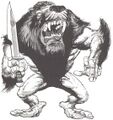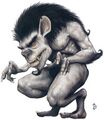Gibberling

"They come screaming, jabbering, and howling out of the night. Dozens, maybe hundreds, of hunchbacked, naked humanoids swarm unceasingly forward, brandishing short swords. They have no thought of safety, subtlety, or strategy, leaving others with no hope of stopping their mass assault. And then, having come and killed, the gibberlings move on randomly back into the night."
- – Monstrous Manual (2e)
Gibberlings are a degenerate species of deformed, pale, ape-like humanoids found in Dungeons & Dragons. They are one of the game's various homages to H.P. Lovecraft, being essentially expies of the Martense family, the xenophobia-degenerated clan from his short story "The Lurking Fear". They first appeared in the original Fiend Folio for Advanced Dungeons & Dragons 1st edition, a creation of a guy known only as "Underworld Oracle". They received a 2e update in the Monstrous Compendium Fiend Folio Appendix, which was reprinted in the Monstrous Manual, and were then reprinted for the Forgotten Realms.
In fact, the gibberlings have become increasingly associated with the Realms; their 3e and 4e updates were both in Realms sourcebooks, namely Monsters of Faerun for 3e and the 4e Forgotten Realms Campaign Guide.
They are perhaps most memorable for their appearance in the Baldur's Gate series, where their ear-piercing, horrific scream as they attack has made a considerable impression on gamers.
Gibberlings are small, hideous, vaguely ape-like humanoids with ties to the Far Realm, insane nocturnal hunters who attack in great numbers. The first impression of gibberlings is of a writhing mass of fur and flesh in the distant moonlit darkness. The pandemonium is actually a mass of pale, hunchbacked humanoids, with pointed canine ears, black manes surrounding their hideous, grinning faces. Their eyes are black, and shine with a maniacal gleam. They carry short swords in their overly long arms as they lope ever faster forward.
It is difficult to imagine a gibberling social structure. It can be roughly compared to the social structure of lemmings throwing themselves into the sea, or of a school of pirhana in a feeding frenzy. There is no sense, no organization, and no individuality. Though they clearly have a primitive means of communicating among themselves, they have no discernable language.
Gibberlings traveling above-ground invariably burrow into the ground to hide during the daytime, and it is at such time that they are most vulnerable. They can easily be tracked by the path of chaos and destruction they leave, and can be quickly dispatched while they lie dormant just beneath the surface of the ground. If uncovered, they awake, but generally cower in fear at the bright light surrounding them, and so are easy prey. Subterranean gibberlings may burrow into the ground, or may simply lie down in a curled, fetal posture at times of rest. They awake suddenly, as a group, and burst in unison out of the ground, howling and gibbering in a most frightful way.
If captured, these strange creatures speak only their own incomprehensible gibberish, and show neither the patience nor the inclination to learn other languages or communicate whatsoever with their captors. Instead, they beat against their cages and fling themselves at barred windows and doorways in pitiful attempts to escape their captivity.
Attempts to find the gibberlings' lairs have inevitably led back to subterranean passages, where the trail is eventually lost in the deepest rock-floored recesses of the caverns.
Gibberlings require a prodigious amount of food to support their manic nocturnal existence, stripping to the bone anyone or anything that should fall in their path. Their fur is commonly infested with lice and other pests picked up during their burrowed slumber. Their hides are vile and worthless. Gibberlings carry no treasure or other useful items. Their swords are of the commonest variety, with no markings or decoration, and are often pitted and dull. In short, gibberlings serve no purpose and no known master, save random death in the night.
In the original 2nd Edition Monster Manual, it was left unclear how or when or even if gibberlings procreate. The mysteries of gibberling reproduction were revealed in the module Gates of Firestorm Peak, which revealed a second form called the brood gibberling, which gives birth to larvae called gibberslugs, which writhe beneath the skin of the brood gibberling. They are injected into the flesh of anyone the brood gibberling bites, including other gibberlings - it can also spit them at victims and let the slugs burrow inside on contact. Unless purged with fire or by eating a Far Realm-touched mushroom called Darkscape, the slugs then grow steadily and consume the body of their host from the inside, eventually bursting out through the skin as a full formed gibberling. A brood gibberling can actually control those it has created, leading to the development of "clans" of the monsters.
Gibberling PCs?![edit]

Yes, as impossible as it is to believe, gibberlings as a PC race actually exist. Perhaps because it predates the appearance of the Brood Gibberling, Dragon Magazine #265 introduced the idea that Gibberlings could become separated from their packs and adjust to life amongst other races. Mind you, this is the same article that introduced the idea that Su-Monsters were actually an intelligent, rational race in their own idea and where Vegepygmy PCs were stated to exist, so take it with a grain of salt.
Gallery[edit]
-
1e
-
2e gibberlings looked more like lions than apes.
-
-
-
The only art to date of the Brood Gibberling. Look close and you can see the gibberslugs.
-
3e





